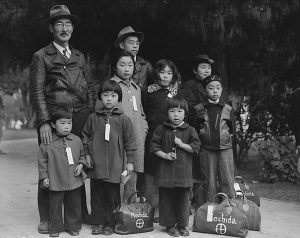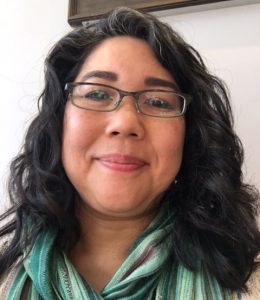By Carol Harada
Photo: Dorothea Lange
A pit of fear grew in my belly when Steve Malosky sat behind me in 4th grade, kicking my chair and muttering about ‘dirty Japs,’ only loud enough so that I could hear. My hair was glossy black. My dark eyes didn’t look like his. My skin had a touch of golden brown. I was always the shortest girl, the smartest, and the quietest. Afraid of speaking up and standing out, yet very observant, full of big questions. But I was never dirty. I learned to lie low, to not rock the boat, as the Japanese saying goes. I realized this kicking boy was doing something bad, but I didn’t see the larger, societal badness until a year later.
When I was about ten years old, I read about Japanese-American internment camps during World War II, first in the novel Farewell to Manzanar. Now they are more directly called concentration camps. 120,000 people of Japanese descent living on the West Coast lost farms, fishing boats, stores, nurseries, homes, family, church, temple – everything – and were imprisoned solely based on race. Two thirds were US citizens. None were ever found to take part in any espionage against the US. Many volunteered and died fighting to rout the fascists and liberate the Jews in concentration camps in Europe, while their own families were held prisoners at home.
They all looked like me.

Photograph of Members of the Mochida Family Awaiting Evacuation
by Dorothea Lange / Wikimedia Commons
My fifth grade teacher, Mrs. Ruland, didn’t believe me when I told her about it, because that shameful part of US history was not widely known back east in the mid-1970’s. My lover in college, whom I thought would understand because he was Jewish, didn’t believe me until he saw an exhibit about it years later. He wrote me to apologize for his ignorance. Even now, many Americans do not know about this massive violation of civil rights born of racist hysteria. But after 9/11, Arabic and Muslim and South Asian communities learned quickly this cautionary tale. Today the Japanese American roundup and incarceration is a blueprint for what NOT to do to our Muslim brothers and sisters. Never again is now.
My parents couldn’t teach me much about racism. They grew up in Hawaii, where Japanese people were a majority in the pan-Pacific rainbow. Japanese, Chinese, Korean, Filipino, Hawaiian, Samoan, Puerto Rican, Portuguese, and white people all lived there. Everyone had their stereotypes about each other, and themselves, but it was done with humor and a sense of strength in diversity. They belonged.
After Pearl Harbor, the entire Hawaiian Islands were occupied territory. A few Japanese were sent to the mainland to concentration camps. My grandfather was dragged away by the FBI and interrogated for being a successful person in his community and church, having frequent correspondence with family in Japan, and never having served in the US military. As a young man my grandfather had been turned away from joining the US Navy, simply because he was Japanese. Catch-freaking-22!
I grew up in the white suburbs of eastern Pennsylvania, where most people were of old European stock. We were one of the few Asian American families there. I felt my minority status acutely, seeing my cut paper silhouette different somehow from all the others on the wall in kindergarten. Maybe that’s when the pit of fear started growing in my belly.
News of the dark side of America reached me early, because I was curious and aware of difference. Around the same time I learned about internment, I saw pictures of white people picnicking under the lynched bodies of black men in those dreadful trees. I saw footage of southern policemen unleashing attack dogs and turning fire hoses on peaceful black people asking for a seat at the diner. I saw the sheer evil of slavery and Jim Crow. I learned about the ongoing civil rights movement and the assassination of Dr. King, this powerful man of peace, this warrior of love with the bow lips and round face. This was before ‘Roots,’ which showed everyone more than we ever wanted to know about our country. It’s more than we ever wanted to reckon with, even now, when it’s most urgent to do so.
If that wasn’t terrible enough, around the same time I saw the TV series ‘World at War’ with my dad, who read and watched everything about World War II. There were the scary Japanese soldiers of Steve Malosky’s nightmares, but not as scary to me as the pale Nazis goose-stepping in their crisp uniforms. Most of all I was horrified by the forever suffering of the Jewish people, culminating in the Holocaust. Those skeletal bodies packed in trains! Turned to ash!
These connected streams of prejudice and hate carried me into an early coming of age, taught me that this was not a safe world for people like me. Or for many, many, many people for random reasons of ancestry, skin tone, belief.
Racism has burned me whenever people have shouted across the street ‘chink!’ or ‘gook!’ or ‘go back to your own country!’ More subtly, people have asked, “Where are you from, really?” as they stared at my inscrutable, ethnically ambiguous face. They thought they were complimenting me: “Your English is so good!” Or the dreaded, blunt cudgel: “What are you, anyway?” This was growing up in retro Pennsylvania, and rarely happens in San Francisco where I now live. But when it does, it shocks me speechless and reminds me of how far we still have to go as Americans. When will we just meet each other, heart to heart?
(About the photo: Date Hayward, California. Members of the Mochida family awaiting evacuation bus. Identification tags are used to aid in keeping the family unit intact during all phases of evacuation. Mochida operated a nursery and five greenhouses on a two-acre site in Eden Township. He raised snapdragons and sweet peas. Evacuees of Japanese ancestry will be housed in War Relocation Authority centers for the duration.)
About the writer

Carol Harada is dedicated to fostering creativity and healing, and the shared territory of spiritual practice. She’s grateful to live in San Francisco and write in the company of Laguna Writers. For more, see deepriverhealing.com and carolharadacreates.com
If you would like to respond to Carol’s piece, please send it to I.am@writingtheresistance.com, and make sure to put Carol’s name in the subject line.


